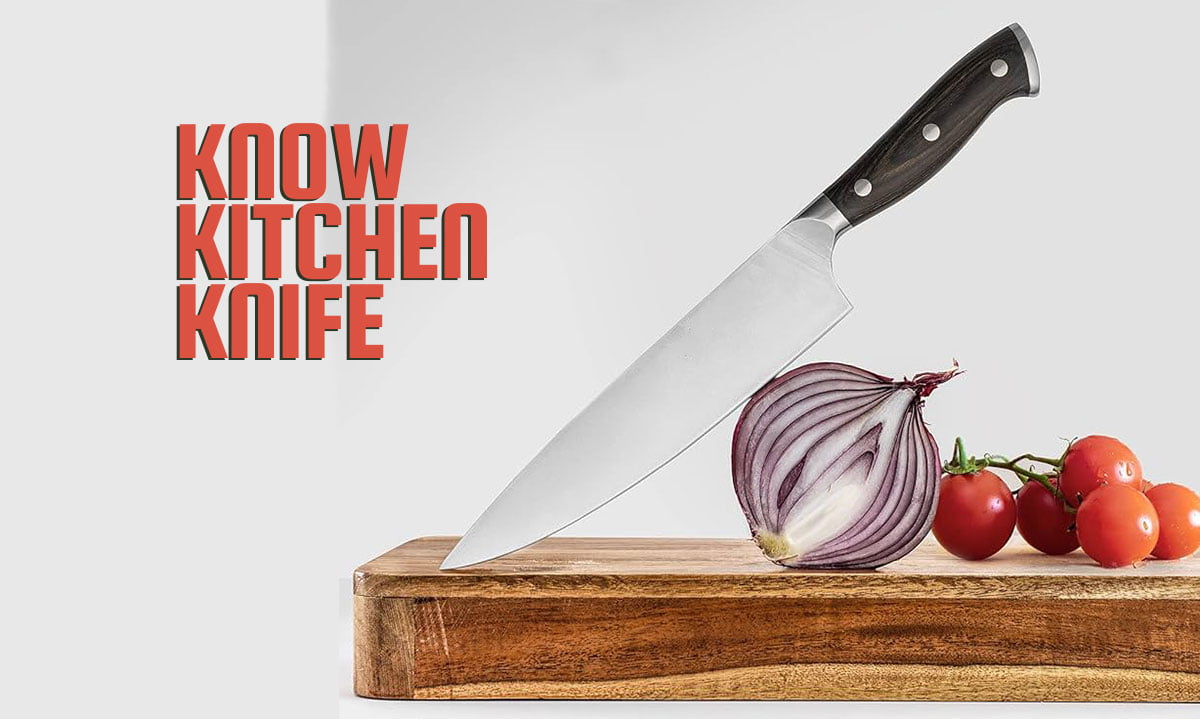A good chef’s knife can handle most of the cutting tasks. However, having specialized knives designed for specific purposes can make your kitchen tasks easier and more precise. The right knives not only simplify the cutting process but also boost your confidence and creativity in the kitchen.
Table of Contents
Introduction to Kitchen Knives Types
There are so many varieties of kitchen knives available, each serving a different purpose. Some are versatile, while others are tailored for specific uses. Let’s explore the most popular kitchen knives that are essential for everyday cooking and food preparation:
1. Chef Knife
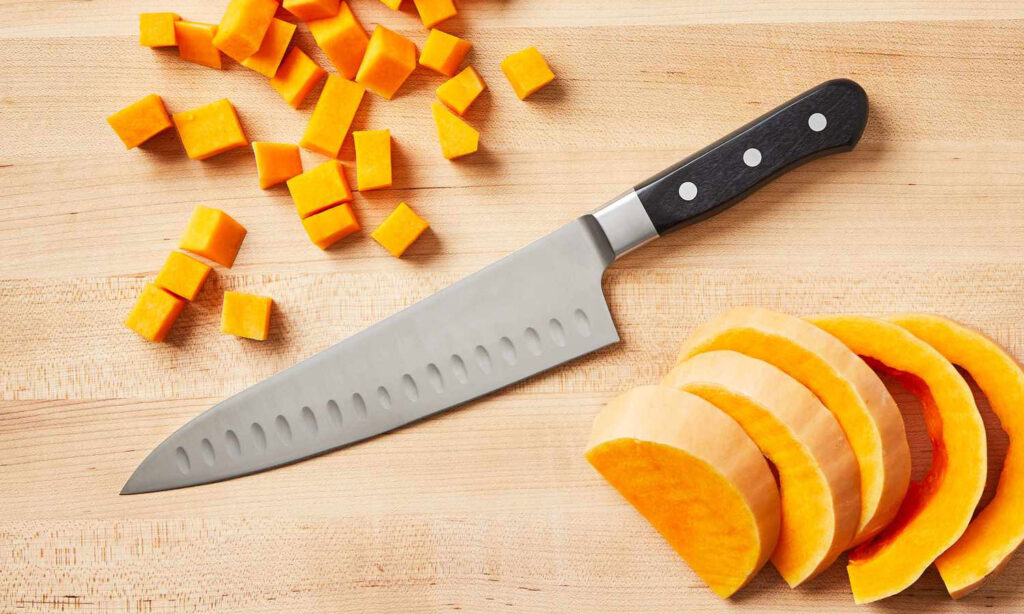
The chef knife is the most versatile type of kitchen knife, making it a must-have item in every kitchen. Also called a cook’s knife, a chef knife has a long, wide blade that tapers to a sharp point. This design allows it to rock back and forth quickly for fast mincing and chopping. They typically feature a straight edge to cut through foods smoothly in a few easy strokes. A chef knife’s blade length ranges in size from 6″ to 12”, with 8″ being the most popular size.
What Is a Chef Knife Used For?
- Chopping herbs and nuts
- Dicing and slicing fruits, vegetables, and meats
- Mincing and crushing garlic
- Cutting through melons
2. Utility Knife
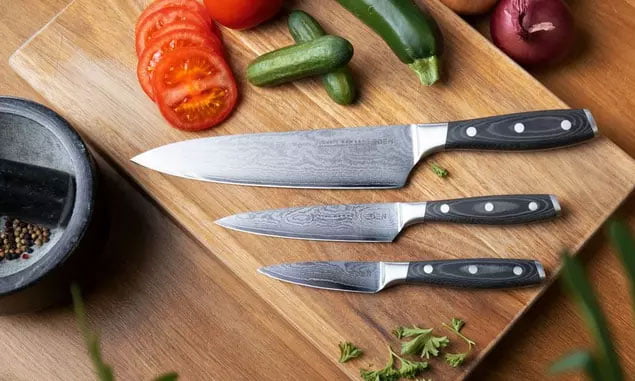
Utility knives are a mix of chef knives and paring knives. A utility knife’s blade is longer than a paring knife and narrower than a chef knife to provide precision for cutting jobs where a chef knife may be too bulky to use and a paring knife too small. They can feature a serrated or straight edge to handle a wide variety of tasks. A utility knife’s blade length ranges in size from 5″ to 9”, with 6″ being the most popular size.
What Is a Utility Knife Used For?
- Cutting small- to medium-sized fruits and vegetables
- Slicing through meats and bread
- Peeling citrus fruits
3. Cleaver
Cleavers easily break down meat, bones, and dense foods. They have a short, wide blade that resembles an axe with a straight edge that makes them useful for chopping and hacking with an up-and-down motion. There are 2 types of cleavers: meat cleavers, which are designed for raw meat prep, and vegetable cleavers, which have a thinner blade and are better suited for chopping vegetables and slicing through fish. A cleaver’s blade length ranges in size from 4″ to 10”, with 7″ being the most popular size.
What Is a Cleaver Used For?
- Chopping vegetables
- Slicing and tenderizing meat
- Crushing garlic
4. Paring Knife
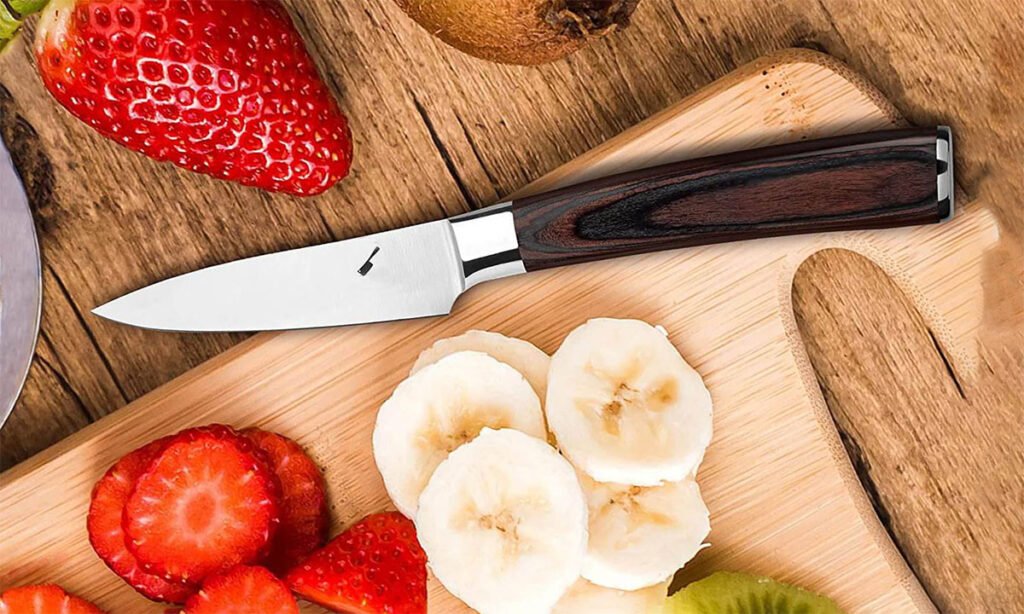
Paring knives are lightweight and have a short blade with a pointed tip that makes them useful for delicate knifework. Their blade lengths range between 2 1/4” and 4 1/2” and can feature a serrated or straight edge to handle a wide variety of tasks. The most common styles of paring knives are the spear point, bird’s beak, and sheep’s foot, which are named after the shape of the blade’s tip.
What Is a Paring Knife Used For?
- Cut, chop, and slice fruits, vegetables, and some cheeses
- Peeling skins for garnishes
- Deveining shrimp
- Trimming excess fat off meat
5. Butcher Knife
Butcher knives have a long, curved blade with a sharp point at the end, which helps with cutting through meat cleanly and easily with a sawing motion. They feature a granton or straight edge to easily slice through meat without tearing or shredding the product. A butcher knife’s blade length ranges in size from 5″ to 12”, with 8″ to 10″ being the most popular size range.
What Is a Butcher Knife Used For?
- Cutting through skin, cartilage, and bones
- Portioning large portions of meat, including whole carcasses, racks of ribs, and beef primal cuts
- Trimming fat and sinew
6. Bread Knife
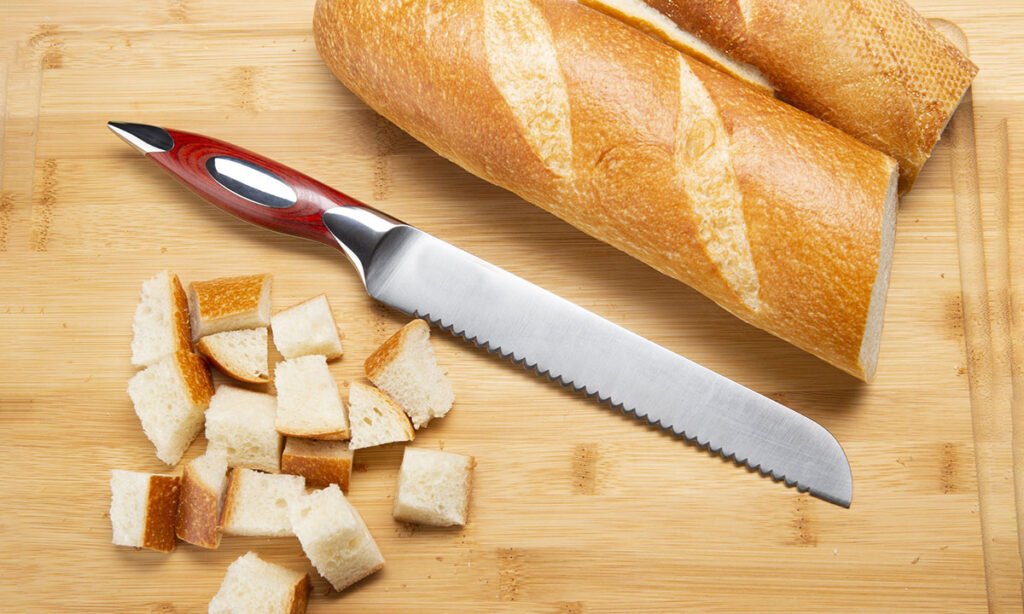
Bread knives have a long, straight blade with a serrated edge that is perfect for sawing through soft items while keeping them intact. Some bread knives feature offset handles, which are designed to prevent the user’s knuckles from hitting the cutting board. A bread knife’s blade length ranges in size from 5″ to 14”, with 8″ to 10″ being the most popular size range.
What Is a Bread Knife Used For?
- Cutting through bread and some cakes without crushing them
- Slice tomatoes without bruising or tearing them
- Slicing through cooked meat and sandwiches
7. Boning Knife
Boning knives can have either a narrow or wide blade that comes in flexible, semi-flexible, or stiff options, depending on the type of meat you are cutting and how maneuverable you need the knife to be. For example, narrow, flexible blades are great for cutting and shaping lamb, veal, and fish whereas a wide, stiff blade is ideal for deboning beef and pork. A boning knife’s blade length ranges in size from 3″ to 12”, with 6″ being the most popular size.
What Is a Boning Knife Used For?
- Separating meat from bones while reducing the amount of wasted meat
- Cutting through cartilage
- Precisely trimming fat
- Filleting fish
8. Oyster Knife
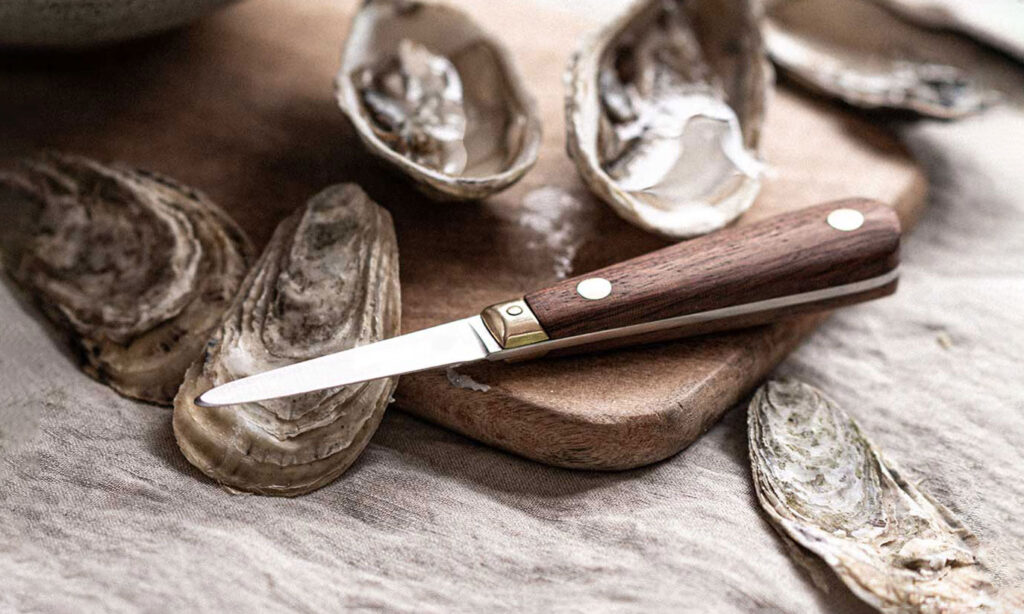
Oyster knives are an essential tool for any restaurant that shucks its oysters. Several types of oyster knives are used for opening different sizes of oysters but they all commonly share a pointed tip that is perfect for unhinging the oyster’s shell. Boston-style oyster knives are the most common oyster knife shape and have long, narrow blades that are effective at opening oyster shells regardless of their size. This makes Boston-style the perfect oyster knife for shucking beginners. Most oyster knives feature an hourglass-shaped handle to ensure a comfortable, secure grip.
What Is an Oyster Knife Used For?
- Opening oyster shells
- Removing the meat from the shell
9. Carving Knife
Carving knives, or slicing knives, have a long, narrow blade that tapers to a sharp point. They are much thinner than chef knives, enabling them to carve thin, uniform slices from cooked poultry and large roasts. This makes carving knives the best knife for carving stations at catered events. Many slicing knives feature granton edges, which reduces drag and prevents the meat from tearing while cutting. A carving knife’s blade length ranges in size from 8″ to 14”, with 10″ being the most popular size.
What Is a Carving Knife Used For?
- Slicing uniform cuts of cooked turkey, ham, chicken, and beef roasts
- Cutting cakes
10. Cheese Knife
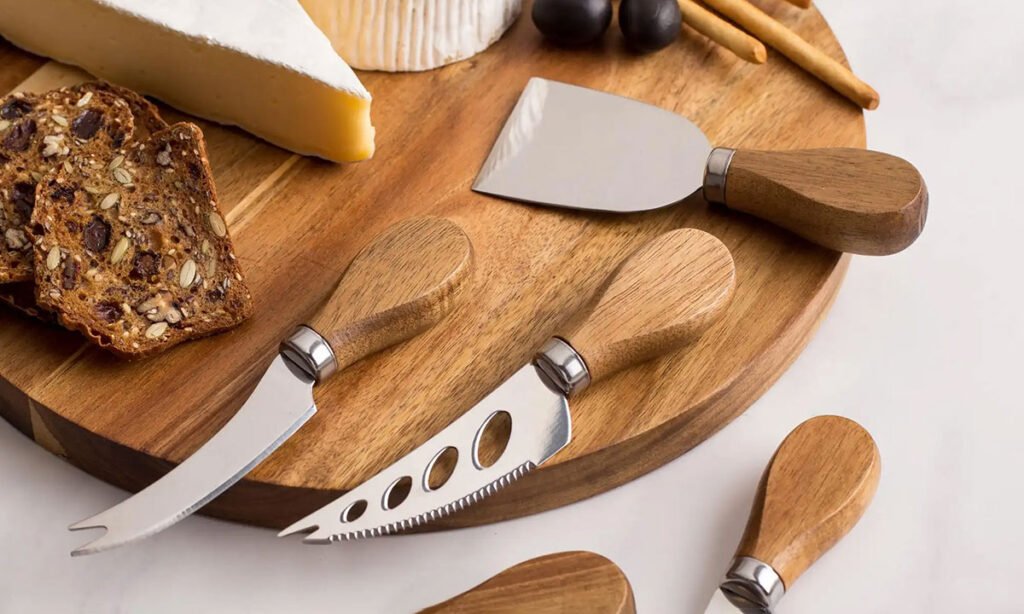
Cheese knives are smaller knives that are typically served with cheese for slicing and portioning. There are several types of cheese knives with different blade styles and lengths that are specially designed to cut through soft, semi-soft, and hard cheeses. Some cheese knives are designed with holes that prevent the cheeses from sticking to them for ease of use. Cheese knives are the perfect tool for restaurants and caterers that offer grazing and charcuterie boards on their menus to enhance the user experience.
What Is a Cheese Knife Used For?
- Slicing cheese on a charcuterie board
- Spreading soft cheeses on crackers
11. Santoku Knife
Santoku knives are a type of Japanese knife that features a wide, straight blade and a curved spine that rounds to the point. Compared to a chef knife, a santoku knife has a thinner, more lightweight blade that is better suited for precise, thin cutting and fine chopping. In most cases, they can be used as an alternative to chef knives in the kitchen because of their all-purpose design. A santoku knife’s blade length ranges in size from 5″ to 9”, with 7″ being the most popular size.
What Is a Santoku Knife Used For?
- Slicing and dicing fruits, vegetables, meats, and fish
- Mincing garlic, meat, or herbs
- Chopping nuts
12. Nakiri Knife
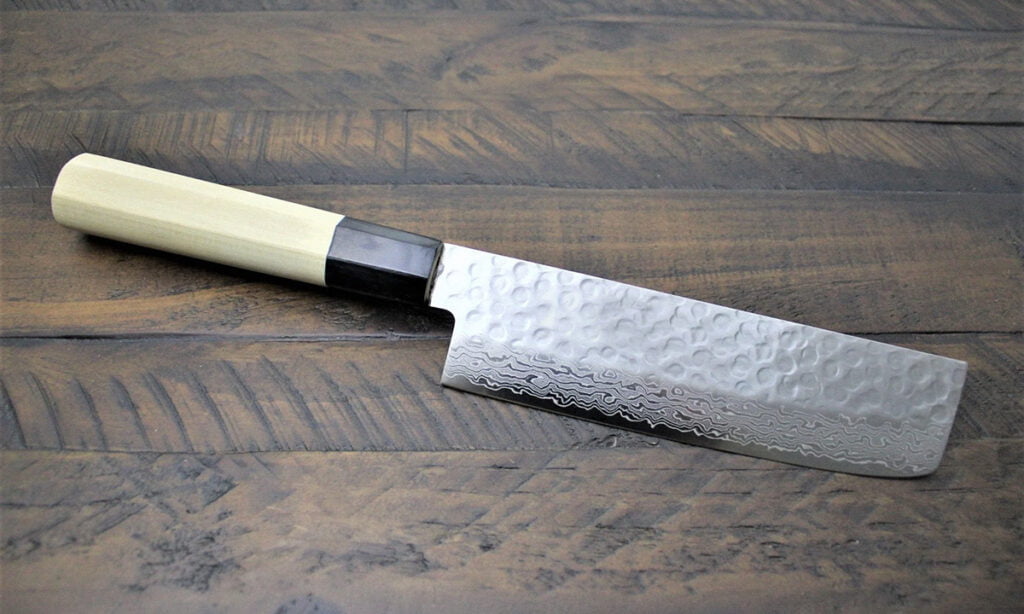
Nakiri knives are Japanese-style knives with a thin, lightweight, rectangular blade and a razor-sharp straight edge. Nakiri knives are slightly heavier than santoku knives since they are designed for straight up and down chopping for precise, clean cuts. It makes quick work of cutting through onions, ginger, and other vegetables. A nakiri knife’s blade length ranges in size from 5″ to 9”, with 7″ being the most popular size.
What Is a Nakiri Knife Used For?
- Slicing, dicing, chopping, julienning, and ribboning vegetables
- Chopping herbs
- Mincing garlic
13. Tourne Knife
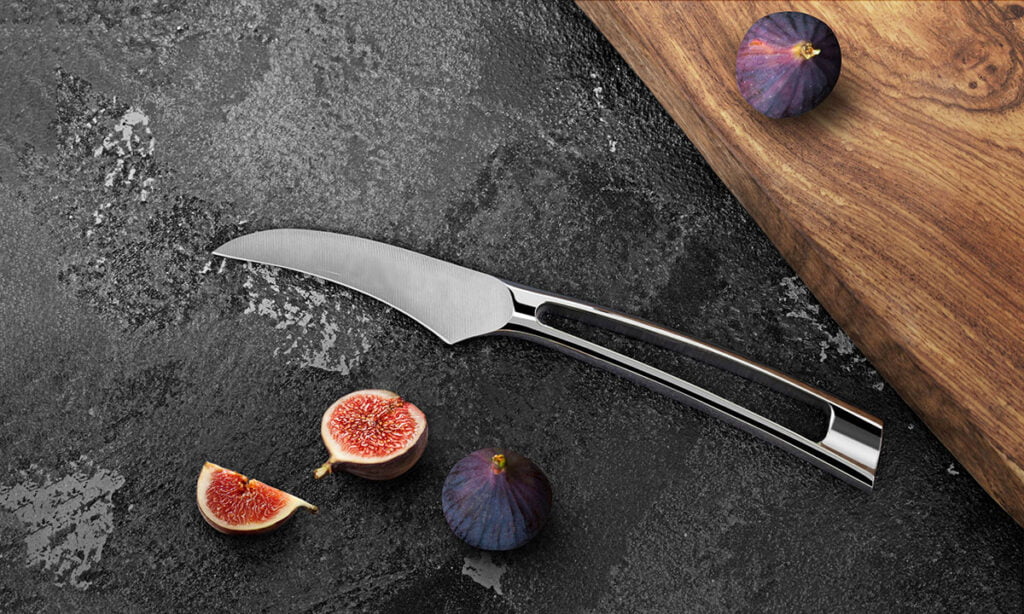
A Tourne knife, or a bird’s beak paring knife, has a short 2 1/4″ to 3″ blade that curves downward, mimicking the shape of a bird’s beak. This allows you to closely grip the knife to peel small and odd-shaped food, such as a knob of ginger, with ease. The Tourne knife is the primary knife used to make tourney cuts, a French technique that involves turning and cutting vegetables into a seven-sided oblong, football shape to promote even cooking.
What Is a Tourne Knife Used For?
- Cutting potatoes, zucchini, carrots, apples, and pears
- Peeling onions, shallots, and round fruits
- Coring tomatoes, strawberries, and Brussel sprouts
- Creating garnishes for cocktails
14. Breaking Knife
Breaking knives are a type of butcher knife that is used for cutting large sections of meat into smaller, more accessible cuts. A breaking knife’s blade is more narrow, thin, and curved than a traditional butcher knife, which gives the user additional leverage and flexibility when cutting through tough skin, cartilage, and small bones. A breaking knife’s blade length ranges in size from 7″ to 10”, with 8″ being the most popular size.
What Is a Breaking Knife Used For?
- Break down whole animal carcasses and larger sections of meat
- Cut through tough skin, cartilage, and small bones
- Trimming the fat off cuts of meat
15. Cimeter Knife
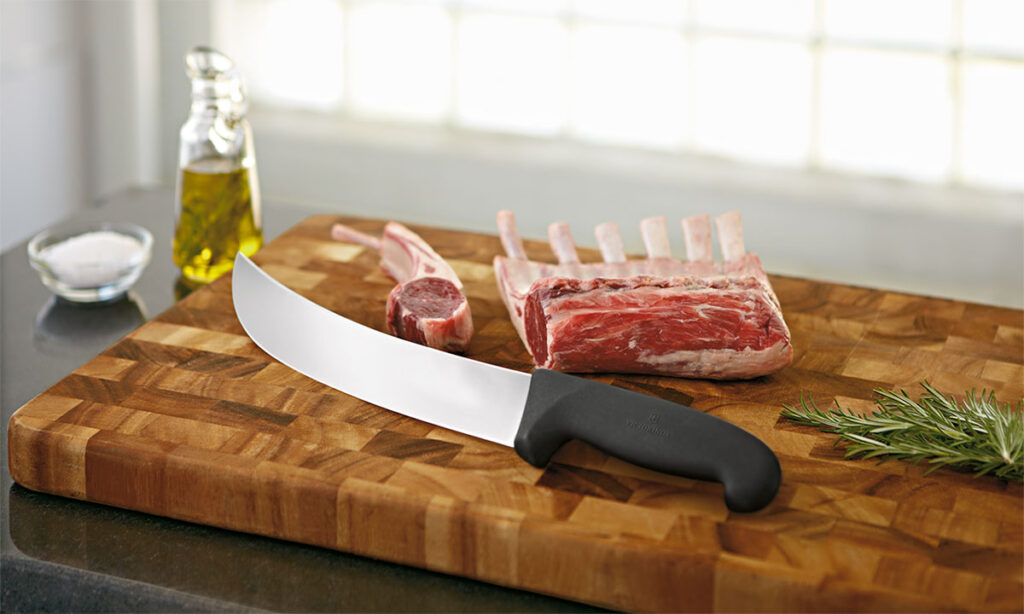
Cimeter knives, or scimitar knives, are a type of butcher knife that is very similar to a breaking knife. Cimeter knives have a long, sharp, curved blade with either a granton or straight edge and are more lightweight than a breaking knife. When used for butchering whole animals, cimeter knives are typically used after a breaking knife as the final portioning knife to trim meat away from the bone to make steak and other retail cuts. A cimeter knife’s blade length ranges in size from 10″ to 14”, with 10″ being the most popular size.
What Is a Cimeter Knife Used For?
- Trim meat and fat off of bones
- Break down sub-primal cuts into retail cuts
Different Kinds of Table Knives
Table knives are very important pieces of cutlery to have for serving food. There are 5 different kinds of table knives. Let’s talk about when to use each one in your business.
1. Butter Knife
Butter spoons are short and wide, and their edges are dull and smooth. This makes it possible to spread butter on bread without cutting it. The edge of a butter knife is duller than the edge of a dinner knife. Its only purpose is to slice and spread butter pats so that guests don’t have to clean their dinner or steak knives before the main course comes out.
- Spread butter, jam, cream cheese, and other spreads with this.
- Serve with English cakes, rolls, scones, and toasted bread.
- Usually found in high-end restaurants, tea shops, and on charcuterie boards
2. Steak Knife
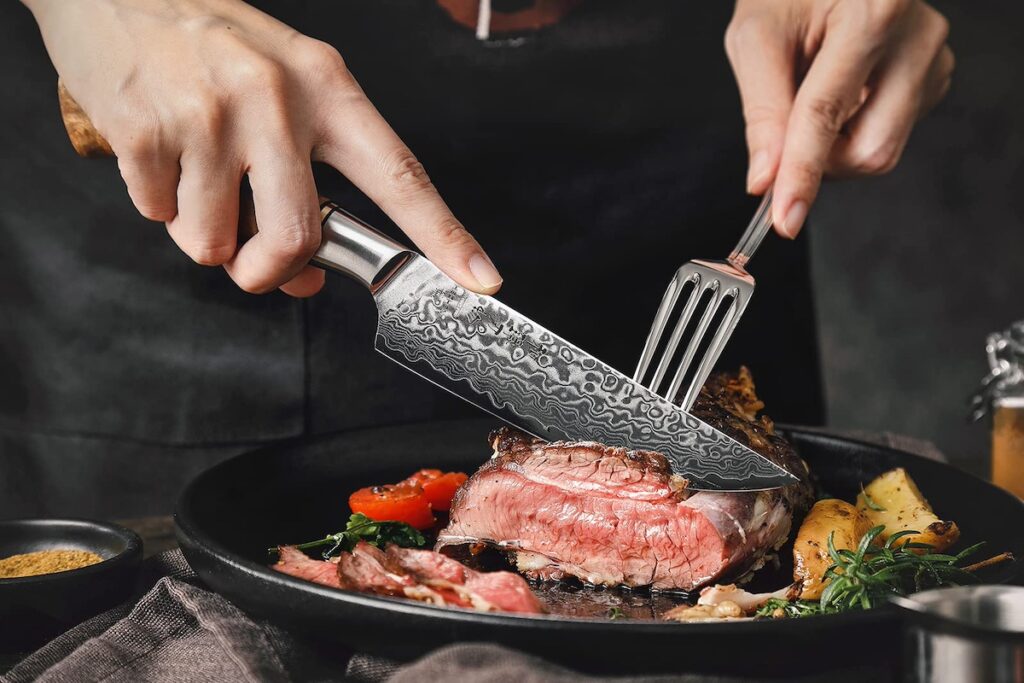
The blade of a steak knife is about the same length as a dinner knife’s, but it has a sharpened edge and a pointy end. This shape helps cut through the crust of meat without hurting the tender inside. It works best for tough foods that are too thick to cut with a dinner knife.
- Great for cutting through steak and pork chops that are tough to cut.
- This is a must-have for steakhouses, fine dining restaurants, and other places that serve a lot of meat. Also comes with different kinds of handle.
3. Steel Fish Knife
In the Victorian era, around 1850, the fish knife was created. At that time, a fancy meal would usually have a soup course, a fish course, and a meat course, and each course would have its own set of cutlery. Fish knives have short, bent blades that look like paddles and are great for cutting through fish skin and meat. The pointy end of the blade makes it easy to remove the tiny bones from fish, which is especially useful when eating a whole fish.
- Great with both fish pieces and whole fish.
- Usually only found in high-end restaurants
4. Dinner Knife for the Restaurant
For breakfast, lunch, and dinner, you should always use a dinner knife. They have a long blade that is slightly bent and a small edge that is serrated so they can cut through many kinds of hot foods. Most of the time, they are made of stainless steel, but they can be finished in silver, gold, or black to match your table.
- Cut meat, veggies, fish, and salad greens with this.
- They come in different colors and handle styles.
5. Dessert Knife
A dessert knife looks a lot like a dinner knife, but it’s a little shorter overall. They are great for putting desserts on because they are clean and don’t get dirty from eating the main course. The edge is slightly scalloped, which makes it easy to cut through soft things like cakes, cheesecakes, and desserts.
- Great for putting pies, cakes, and other treats on.
- Perfect for high-end restaurants, hotels, and parties that are served
What are the Parts of a Knife
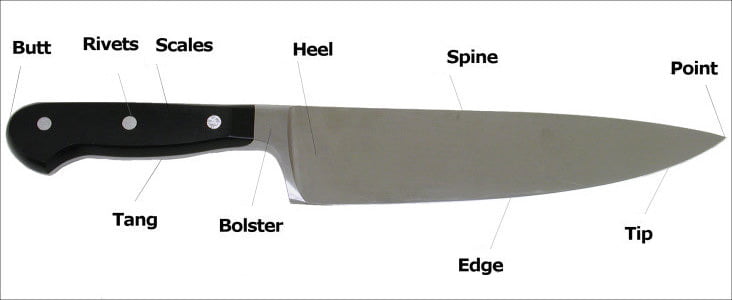
To learn about the different kinds of kitchen knives and how they’re different, you need to know what each part does. The picture below will help you figure out what each part of your kitchen knife does.
Bolster: The bolster is only on knives that were made by forging. There is a thick steel band between the heel and the handle that helps keep the knife’s weight in check and keeps the user’s hand from moving.
Butt: The end of the knife’s handle is called the butt.
Edge: The sharp side of the knife blade that you use to cut is called the edge. Keeping the edge of your knife sharp keeps you from cutting yourself.
Handle: The part of the knife that you hold is called the handle. The scales is another name for this part of the knife.
Heel: The heel is the back part of the blade, and it’s usually used for tough cutting jobs like cutting meat or tough veggies.
Point: The knife’s point is the point. People often use it to pierce through things.
Spine: The side of the knife blade that is not sharpened and is across from the edge.
Tang: The part of the blade that goes into the handle to keep it balanced is called the tang. People think that full-tang blades are better for balance and longevity. A sub-tang or half-tang knife costs less but doesn’t last as long.

